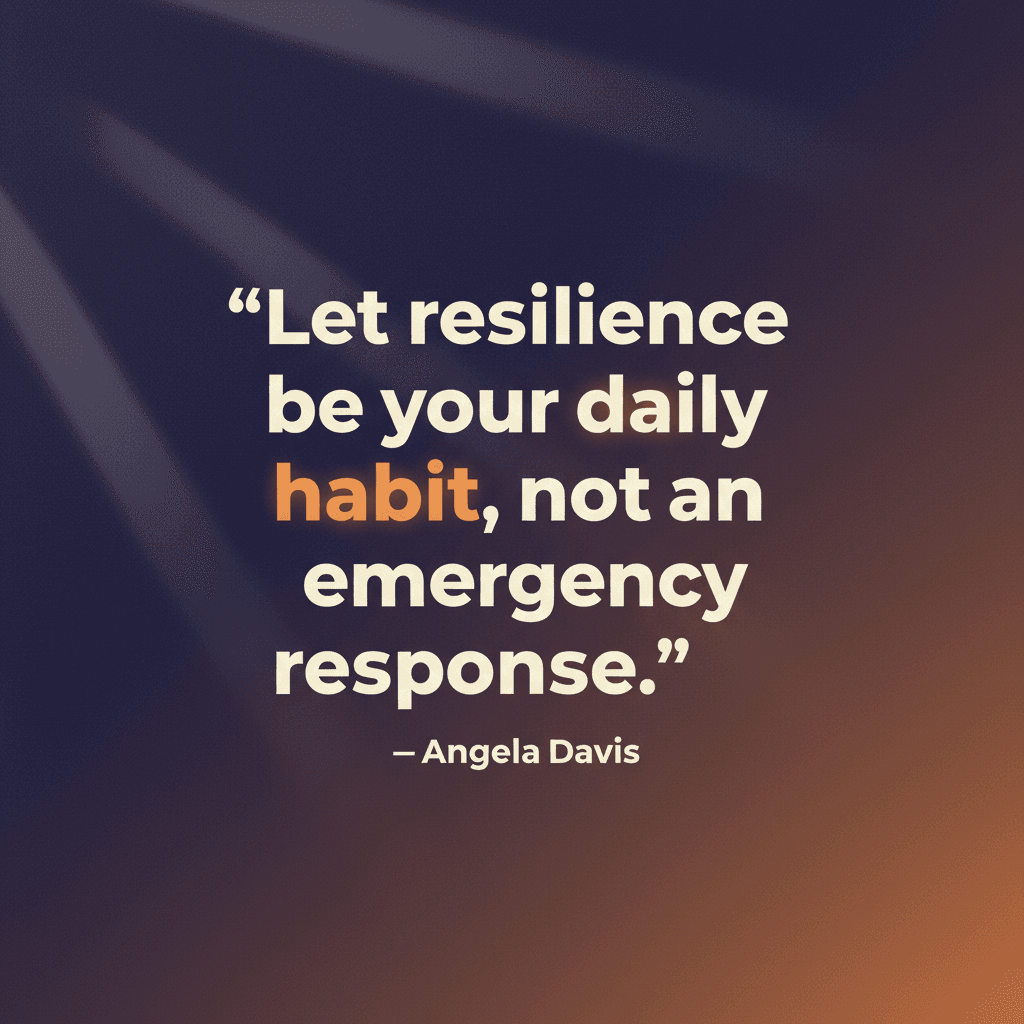Resilience Works Best as a Daily Habit

Let resilience be your daily habit, not an emergency response. — Angela Davis
From Crisis Reflex to Daily Practice
Angela Davis’s counsel reframes resilience from a last-minute scramble into an ongoing discipline. Rather than waiting for disruption to force improvisation, daily habits—small, repeated acts of preparation—accumulate into reliable strength. Just as you cannot install sprinklers after the fire starts, you cannot summon steady judgment, clear communication, or mutual trust without practicing them before stakes rise. Consequently, resilience becomes less about heroics and more about maintenance. By rehearsing how we pause, ask for help, and reset under mild pressure, we reduce the drama of emergencies. Over time this routine converts resilience from a personality trait into a skill set, ready on demand.
Long-Haul Lessons from Movements
Davis’s own tradition of organizing underscores that endurance is built in ordinary time. In Freedom Is a Constant Struggle (2016), she points to sustained, everyday work—study groups, court support, phone trees—that made rapid response possible. Consider the Montgomery bus boycott (1955–56): its 381 days didn’t run on adrenaline; it ran on carpools, schedules, and community funds refined day after day. Similarly, prison abolition campaigns rely on routine letter-writing, bail funds, and legal education that precede headline moments. These mundane, repeatable practices harden into infrastructure, so when crises strike, communities act from muscle memory rather than panic. Thus political resilience mirrors personal resilience: the preparation is the practice.
The Psychology of Habitual Grit
Behavioral research shows that consistency beats intensity. Habits embed through context cues and repetition, not willpower alone. In a study of real-world habit formation, Lally et al. (European Journal of Social Psychology, 2010) found automaticity grows gradually, with a median of about 66 days. Implementation intentions—if-then plans like “If I open my laptop, I first review my priorities”—help behaviors fire reliably (Gollwitzer, 1999). Translating this to resilience means scripting tiny, regular drills: a two-minute breathing reset before meetings, a daily “what went wrong/what I learned” note, or a weekly failure prebrief with a colleague. Because these actions are small, they are sustainable; because they are repeated, they compound into reflexes.
Training Body and Brain for Stress
Psychology and physiology converge on the value of practicing under manageable load. Stress inoculation training (Meichenbaum, 1977) exposes people to controlled stressors plus coping skills, improving later performance. Likewise, McEwen’s work on allostatic load (1998) shows that chronic unmanaged stress degrades health—while structured recovery and predictable routines buffer the system. Daily resilience habits can therefore pair micro-challenges (cold showers, timed focus sprints, courageous but low-stakes conversations) with micro-recoveries (paced breathing, brief walks, consistent sleep). Fire departments drill donning gear; athletes practice under fatigue; we can rehearse calm cues—exhale longer than inhale, name the problem, choose the next right action—until they stick. When pressure spikes, the body recognizes familiar moves.
Everyday Systems for Organizational Resilience
Teams that thrive in crises build rituals before they need them. Pre-mortems ask, “It’s six months later and our plan failed—why?” (Klein, 2007), turning foresight into routine. Netflix popularized chaos engineering, deliberately breaking parts of a system in normal times to reveal weaknesses (Chaos Monkey, 2011). Hospitals run regular mock codes; aviation relies on briefings and checklists (Gawande, The Checklist Manifesto, 2009). These practices normalize error detection, shorten feedback loops, and reduce blame. A daily five-minute stand-up that surfaces one small risk and one small fix seems trivial—until the day it prevents a cascade. Thus, organizational resilience grows from modest, boring, repeated processes that make surprises less surprising.
Resilience Without Burnout or Blame
Finally, making resilience a habit must not become code for “endure more.” Institutions sometimes weaponize the term, shifting systemic problems onto individuals. Healthy resilience intertwines with boundaries and recovery: periodized workload, protected sleep, and psychological safety. NASA’s fatigue studies treat sleep as mission-critical, not a luxury (NASA, 2014). Sports science echoes this: adaptation occurs during recovery, so rest is training. Practically, teams can schedule recovery blocks, rotate on-call duties, and track workload as carefully as output. By pairing daily stress management with daily restoration, we keep resilience from masquerading as stoicism. The goal is not to harden hearts, but to keep them steady—and available—when others need them most.